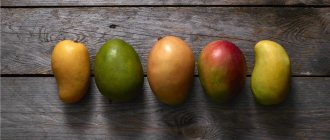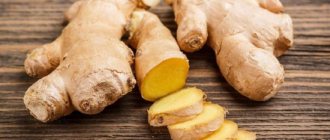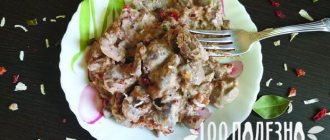Mango fruit
Where does it grow
Mango grows in tropical countries, and India is considered the birthplace of this evergreen tree, which bears large, tasty fruits. On Indian lands, mangoes still thrive today, basking in the rays of the hot sun. It also grows in Pakistan, Egypt, Indonesia, and Thailand.
In total, there are up to 30 species of this fruit in nature.
What a taste
Mango has an interesting taste - a mix of peach and pineapple, flavored with carrot sweetness. This combination is fascinating, you want to try it again and again. It is not surprising that mango has many admirers far beyond its tropical homeland.
The fruits come in red-green and yellow colors. Color has little effect on the taste of the fruit if we are talking about ripe fruit.
What it looks like: photo
Mango trees are very tall, up to forty meters. True, cultivated species are smaller in height, but they bear much more fruit. The fruits themselves are large, individual specimens reach two kilograms. Medium-sized mangoes weigh about half a kilo. The leaves of the trees are dense, long, up to half a meter in length.
Young trees show off in pink and orange – this is the color of the foliage. As the tree matures, the leaves change from pink to red and then turn green. During the flowering period, the trees are covered with yellow or white flowers; this sight cannot leave you indifferent. Small flowers form powerful clusters, each cluster is almost half a meter long.
Growing mangoes at home
Mature trees can reach heights of up to 35–40 meters and have a 10-meter crown. Their root system goes deep to 5–6 meters, and they can bear fruit for up to 300 years. Of course, such giants and long-lived people are unlikely to find a place in a garden plot, much less in a pot, but they managed to tame mangoes for growing at home. By the way, evergreen mango trees grow in open areas in the warm tropics and subtropics, but not in our climate.
How to grow mango from seed
Seeds are obtained from ripe and even overripe, soft fruits. It is quite easy to germinate them; the probability of a positive result is more than 90%.
The seed must be carefully removed from the shaggy coat, treated with a manganese solution or fungicides (protects it from fungus), wrapped in a napkin moistened with water or sent to a container with wet sawdust and kept in a warm place until the sprout hatches (7–14 days). Or you can immediately plant the seed in “universal” soil (pH 7), purchased at the nearest flower shop.
Photo: © Thamizhpparithi Maari
Mango in a pot
The first pot for the future plant can be a large plastic cup. It will need to be placed under a “24-hour” phytolamp. In summer, it is allowed to use a window without additional lighting, but the sprout will develop more slowly. It is recommended to cover the top of the glass with film, but lift it daily for ventilation. The watering mode is selected individually - the soil should not dry out or flood.
When the young plant gets stronger, it should be transplanted into another pot - quite spacious and deep, with drainage holes. You will need to lay drainage at the bottom - about 5 cm of crushed stone, broken brick, crushed foam or expanded clay.
Important! It is recommended to plant mango seeds with the sprout facing down.
How to germinate mangoes from seeds: video
It is recommended to place the pot with the plant in a warm, bright place, but without direct exposure to sunlight. In summer, it can be taken out onto the balcony, open terrace and even into the yard, but only for a day, since temperature changes are dangerous for southern mangoes. Watering - approximately once every 2-3 days, and the leaves should be sprayed with a spray bottle or wiped with a damp cloth. The tree needs to start feeding at one year of age every two weeks in spring and summer. To prevent the mango from growing and starting to bush, its top must be pinched when it reaches a meter in height.
It is necessary to transplant the plant into a larger container if it feels cramped in the old pot. Signs may include roots appearing in the drainage holes or a significant slowdown in the rate of development.
Fruits at home
Many housewives would dream of growing fruit on their windowsill or at least in a warm loggia. But even with good care, this is impossible in our latitudes. Mango at home can only be considered as an ornamental plant. It will probably delight you with flowers after 5–10 years, although gardeners assure that the plant is successfully grafted, and if conditions permit, then with proper luck, fruits will appear.
Photo: © David Stanley (CC BY 2.0)
Benefits of fruit
Mango is an amazing gift of nature. It contains many useful substances, vitamins, and minerals.
So, it contains a lot of ascorbic acid, which, as everyone knows, increases the level of immunity of the body. A lot of beta-carotene, which is responsible for the vitality of the body. There are many vitamins B and E, without which the normal functioning of many organs is impossible. Potassium and magnesium contained in mangoes support the functioning of the heart and blood vessels, phosphorus is responsible for bone health. The fruits contain many useful amino acids and sugars synthesized in the body. There are phenolic compounds, polyphenols, which act as antioxidants and protect cells from damage, and are also responsible for blood quality.
Mango helps with:
- Hypertension;
- Painful menstruation;
- Diseases of the nail plates;
- Obesity;
- Anemia.
The fruit is recommended to be used:
- For active brain function;
- As protection against cancer;
- For weight loss;
- To remove excess cholesterol from the body;
- To support male strength;
- To reduce pain during physical training;
- To maintain the health of pregnant women and the fetus.
Mangoes can also be eaten by nursing mothers, unless, of course, the taste of the fruit is new, if the woman enjoyed it before pregnancy. However, you need to eat it in small portions so as not to cause an allergic reaction in the baby.
Children can eat mangoes, but not earlier than two years of age. The best option is mashed puree.
Chemical composition and calorie content
Nutritional value per 100 g of mango pulp (Mangifera indica):
- Calories: 70 cal.
- Carbohydrates: 17 g
- Dietary fiber: 1.8 g
- Fat: 0.27 g
- Protein: 0.5 g
| Vitamins and minerals | Quantity | % of daily value |
| Folates | 14 mcg | 3,5 |
| Niacin | 0.584 mg | 3,5 |
| Pantothenic acid | 0.160 mg | 1 |
| Pyridoxine | 0.134 mg | 10 |
| Riboflavin | 0.057 mg | 4 |
| Thiamine | 0.058 mg | 5 |
| Vitamin A | 765 ME | 25,5 |
| Vitamin C | 27.7 mg | 46 |
| Vitamin E | 1.12 mg | 7,5 |
| Vitamin K | 4.2 mcg | 3,5 |
| Potassium | 156 mg | 3 |
| Calcium | 10 mg | 1 |
| Copper | 0.110 mg | 12 |
| Iron | 0.13 mg | 1,5 |
| Magnesium | 9 mg | 2 |
| Manganese | 0.027 mg | 1 |
| Beta carotene | 445 mcg | — |
| Alpha carotene | 17 mcg | — |
Mango fruits are rich in prebiotic dietary fiber, vitamins, minerals and polyphenolic antioxidants. The fruit contains:
- Flavonoids and carotenoids (beta-carotene and alpha-carotene) – these compounds have antioxidant properties and are essential for good vision.
- Vitamin A is needed to maintain healthy mucous membranes and skin, as well as for normal vision, beautiful skin, reproductive health and normal cell development.
- Potassium is an important component of cellular fluids that helps control heart rate and blood pressure.
- Vitamin C is essential for the normal functioning of the immune system, strong connective tissue and healthy blood vessel walls.
- Vitamin B-6 (pyridoxine) – controls homocysteine levels in the blood, is beneficial for blood vessels, prevents coronary artery disease and reduces the risk of stroke.
- Copper is necessary for the production of red blood cells.
Mango peel is also beneficial for the body, it is rich in phytonutrients responsible for its vibrant color, in particular carotenoids and polyphenols.
Contraindications
Mango, despite its usefulness, should be excluded from the diet for people who suffer from allergic reactions. Quincke's edema due to a tasty fruit is an unpleasant “surprise”.
It is dangerous to eat green fruits; they contain too much ascorbic acid. This may cause stomach cramps.
It is not recommended to eat a lot of mangoes. The maximum is a couple of fruits per day, otherwise the functioning of the digestive system can be disrupted. In addition, you need to remember that the fruit is prohibited from being consumed with alcoholic beverages; this fruit significantly slows down the breakdown of ethyl alcohol.
You should be careful and not feast on exotic fruit if you have kidney problems or liver disease.
How to properly peel a mango before eating?
The difficulty in peeling mangoes lies in the presence of a large oblong seed, which is difficult to separate from the pulp.
- Before use, the pulp must be freed from the skin. It is necessary to wash the fruit thoroughly, because the journey it took was very long.
- It is recommended to wash fruits with soda. For long-distance transportation, fruits are treated with wax. Dry the fruit with a paper towel. Mostly here you can find oval and oblong mangoes; it is more convenient to cut them by placing them vertically on a board, and it is best to use a plate, because if the fruit is juicy, then all the juice will flow out during the cutting process.
The first method is suitable if you eat mangoes outdoors in the absence of a knife. This method is not very good, because you will get dirty.
If you decide to eat mango, then this is the cleaning method for you:
- Pick up the fruit with the root facing you.
- Cut off the tip and open it like you would open a banana.
- Holding it by the peel, eat the flesh right down to the pit.
It is better to put mango in the refrigerator before eating. Cut it along the growth of the bone in a circle into halves. Turn the flesh out and scoop out the pulp.
Peeling the mango
Another way to cut a mango:
- Cut the mango into 2 slices to remove the pit.
- Using a knife, without catching the skin, make cubes.
- Turn the flesh out.
You can also remove the peel using a potato peeler and then cut it into slices or cubes.
- If you decide to treat your guests to this juicy fruit, it is better to choose a cutting method in which you will not get dirty or stain everything around, and the pieces will be neatly cut.
- It is better to store peeled mangoes in a cool place, but store whole mangoes in a dark place at room temperature. If the fruit is slightly overripe and very soft, eat it with a spoon, cutting it in half.
It is better for children to prepare puree, but not using a blender; there is a more original way. Take a ripe mango in your hands and gently press until it becomes pureed. Be careful not to damage the outer shell. To eat the pulp, simply make a small cut and squeeze a little bit of the pulp into your baby's mouth.
puree
can be consumed either in its pure form or as an addition to desserts, snacks or main courses. It is best to eat mango as an independent product, because it has a bright taste on its own. It is recommended to use a knife and fork when cutting it into slices or cubes. True, not everyone follows the rules of etiquette outside restaurants and cafes.
During the hot season, you can make sorbet from mangoes. Be careful, because the fruit is sweet like honey and has a bright yellow color; if it gets on your clothes, it can ruin it. Mango can also be added to desserts by pureeing it using a blender and served with ice cream.
Mango is one of the components of sauces, the most famous in Latin America is “salsa”. Mango is one of the ingredients in Asian curry sauce. It is also a great addition to main dishes as a side dish called chutney. We are used to adding mangoes to salads, but only to fruit salads. In Asia, this is a great addition to salads with shrimp and seafood. It is used to make yoghurts, smoothies, and eaten with cream cheese. Mango is a great addition to pies. You can make delicious preserves, jams, and candied fruits from it.
How to choose ripe
On store shelves you can find two types of mangoes - yellow and greenish-red. To choose a ripe fruit, you need to pay attention to the color of the fruit and its density.
It’s easy to choose a yellow fruit: the richer the color, the more ripe the fruit.
If green-red fruits are sold, then, based on color, you can make a mistake and buy unripe fruit. Therefore, you need to take the fruit in your hand and squeeze it slightly. The fruit should regain its shape after squeezing. A good fruit should not leave a dent.
If the fruit is not squeezed at all, then it is unripe and should not be taken. But if you want to buy fruit, it is better to let it ripen. And not in a cold place! In the refrigerator, the mango will remain unripe. It is better to wrap the fruit in paper and leave it for several days.
Botanical characteristics
Today there are over 2,000 different varieties of mangoes. They are conventionally divided into 2 types: Indo-Chinese (greenish and elongated fruit), Indian (orange-yellow and round). In addition, intervarietal hybrids are known - Indo-Chinese.
The most popular crops suitable for growing in a small garden or in a container on the balcony include the following crops:
- Cogshall;
- "Carrie"
- "Fairchild"
- "Ice Cream";
- "Julie"
- Lancettila;
- "Brooks";
- Mallika;
- "Okrung"
- "Neelum"
The weight of a ripe mango fruit is 200 - 300 grams, and the diameter depends on the plant variety and varies from 10 to 20 centimeters. The fruit tastes vaguely like a peach. The color of the skin depends on the variety and can be yellow-green, deep orange, pink, red, purple.
Mango is an evergreen tree of the tropics that reaches 20 meters in height. This is one of the most durable fruit species. The number of flowers in inflorescences reaches up to 4000 pieces. However, their binding rate is extremely low. A maximum of 2 fruits ripen in one inflorescence.
If the fruit is excessively sour, it is spoiled; if it is tasteless, it is unripe. Ripe fresh mango is sweet, fleshy and juicy, smooth to the touch, elastic with a shiny surface. The presence of dents, defects, or damage indicates that the product has begun to deteriorate.
Small black spots, on the contrary, indicate the ripeness of the fruit.
Wrinkled skin is a sign of stale fruit. If the surface of the mango is wet, then the juice is seeping out. This indicates that the fruit is damaged internally.
When pressed, the peel of a ripe mango springs back and crushes under your fingers. After light pressure, it should restore its original shape. The smell of fresh ripe fruits is sweetish, resinous, coniferous, and is strongly manifested at the stalk. If the mango does not smell, it means it is not yet ripe; it exudes an intense aroma - it is overripe.
The shape of the mango depends on the type of tree and can be elongated-ovoid, spherical, pear-shaped, ovoid. In the center of the fruit there is an inedible, large and heavy seed, 10 centimeters long and weighing 50 grams. The outside of the bone is covered with a protective shell.
Do I need to peel it?
Mango is a great dessert. It can be eaten raw by cutting off the crust, or it can be used as an ingredient in dishes. Salads, appetizers, main courses with meat and fish are prepared with it, subjecting the fruits to heat treatment. Juice from the fruit is good. Culinary masterpieces with mangoes also have their fans.
Before cooking, wash the fruit and remove the crust. The pulp is chopped. If the fruit is hard, you can cut it into pieces. If it is soft, then in order to remove the pulp, you can take an ordinary spoon and scrape the pulp from the walls of the peel.
Why are mangoes eaten without the peel? It's all about its hardness and toxic composition. The peel protects the pulp from external factors, and this is its main purpose. But the peel should not be eaten. It contains the toxic resin urushiol, which is hazardous to health. Even a small amount of peel eaten can cause stomach and intestinal disorders.
Urushiol may also cause an allergic reaction. Some people, especially those prone to allergies, will easily get sick even if they touch mango peel. Redness and blisters appear on the skin, like a nettle burn. Such people need to be extremely careful when feasting on exotic fruit.
What to cook with mango
Mango is wonderful on its own. But in combination with certain ingredients, the taste and aroma of the fruit are revealed in a new way.
Mango jam
Ingredients
- 2–3 mangoes;
- 200 g sugar;
- 60 ml water;
- 1 teaspoon grated lemon zest;
- 1½ tablespoons lemon juice.
Preparation
Puree the mango pulp in a blender. Pour sugar into a saucepan, add water and place on low heat. Cook, stirring, until sugar dissolves.
Combine the syrup with mango puree. Add the zest, stir and cook for 2-3 minutes. The jam should bubble a little. Pour in the lemon juice and cook, stirring, for about 15 minutes until the mixture thickens.
Drop a little onto a plate and tilt it. If the jam does not run out, it is ready. Store the dessert in a closed container in the refrigerator for no longer than two weeks.
Experiment











